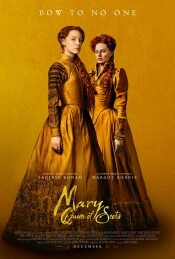At first glance, Mary Queen of Scots has all the makings of a film you’d expect to be nominated for numerous awards; after all, it’s a period drama that showcases some remarkable performances from Saoirse Ronan and Margot Robbie. Unfortunately this retelling of the story between Queen Elizabeth (Robbie) and Queen Mary (Ronan) is bogged down with its politics and the struggles these women have being leaders while their differing religions present a conflict preventing them from ever working together. Let me just jump into this and attempt to sort this film out.
For those who are not history buffs, I won’t disclose who it is that we see in the opening moments of the film as they are being led to their execution. It’s an odd way to open the film; despite it being historically accurate, it just seems a bit off-putting. The film then takes us to Mary arriving in Scotland to claim her throne after being away in France. At the same time Queen Elizabeth has been ruling over England and Scotland, since she hasn’t married and with no children it is Mary who is ready to take on the reins of becoming the heir to the throne of England. This is the start of many squabbles between the two queens, where we see their relationship dissolve from a unique sisterhood to the pair becoming envious of one another. Basically how most families are, only without the royal labels.
From the start, what fuels this film is the anticipation of seeing Elizabeth and Mary finally meeting, as with each attempted meeting gets delayed in some manner the tension continues to rise. Seeing how these women square off against the men who seek their attention and power definitely has its moments, though it’s a shame when we see how easily Mary seems to be swayed by a suitor whom she foolishly marries. The turmoil only continues to intensify as Mary’s life and throne are on the line, and it is here where things seem to spiral a bit out of control. The problem is the film aims to deliver us to see these women square off. History tells us that it seems the women never met to begin with, but this is cinema; “truth” is allowed to be toyed with. When the moment does finally arrive where we see them together, it is beautifully shot and performed, but if anything it still feels anticlimactic. And basically that is how the rest of the film is.
Aside from the great performances, what stands out most is the cinematography and the costume designs. While there is elegance to the film, the sets and costumes feel properly lived in and authentic to the time. When we see Queen Elizabeth as she is suffering from smallpox, her scars and her makeup simply elevate the performance that Robbie delivers.
The film’s downfall is with the script; there is simply too much story crammed into a two-hour film with the expectation that the viewers are all able to follow along. Basically by doing this the film loses out on picking up the casual filmgoers, which is a bit of a risky gamble. If the film had a perhaps thirty minutes tacked on to give the plot some time to breathe, rather than feel so jumbled and rushed, this could have been a different experience altogether. Still, the film will have its fans, but I’d expect this to be overlooked with The Favourite gaining buzz.



